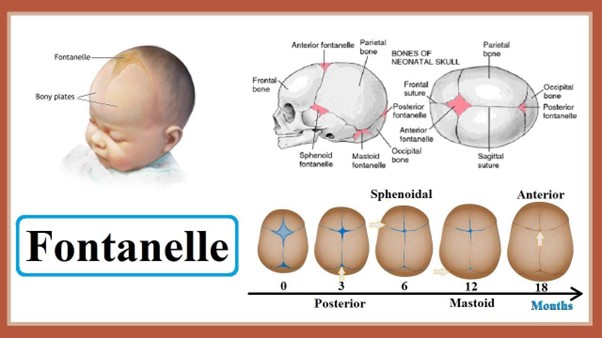A nurse is assessing the fontanels of an 8-month-old infant. Which of the following findings should the nurse recognize as an expected finding
The anterior fontanel is open.
Both fontanels are the same size.
The posterior fontanel is open.
Both fontanels show moulding
The Correct Answer is A
Choice A reason
The anterior fontanel is open is the correct answer. An expected finding in an 8-month-old infant is that the anterior fontanel (the soft spot on the top of the baby's head) is open. The fontanelles are spaces between the bones of an infant's skull that allow for the baby's brain to grow and the skull to mould during birth.
The anterior fontanel typically remains open until the baby is around 18 to 24 months old, with the closure process starting sometime after 9 months of age. Therefore, at 8 months of age, it is normal for the anterior fontanel to still be open.
Choice B reason:
Both fontanels are the same size is incorrect. Both fontanels are usually not the same size. The anterior fontanel is larger and diamond-shaped, while the posterior fontanel is smaller and triangular.
Choice C reason:
The posterior fontanel is open is incorrect. The posterior fontanel, located at the back of the baby's head, usually closes earlier than the anterior fontanel. It typically closes within the first few months after birth, so it is not expected to be open at 8 months of age.
Choice D reason
Both fontanels show molding is incorrect. Molding refers to the temporary shaping of the baby's head during birth due to the pressure exerted during the passage through the birth canal. By 8 months of age, the molding typically resolves, and the baby's head should have a more rounded appearance.

Nursing Test Bank
Naxlex Comprehensive Predictor Exams
Related Questions
Correct Answer is D
Explanation
The correct answer is choiced. A client who is taking warfarin and has an INR of 1.8.
Choice A rationale:
An induration after a Mantoux test indicates a positive reaction, but it does not necessarily require immediate follow-up unless the induration is significant and the client has risk factors for tuberculosis.
Choice B rationale:
Sodium phosphate is commonly used as a bowel preparation for colonoscopy. This does not typically require follow-up unless the client experiences adverse effects such as dehydration or electrolyte imbalance.
Choice C rationale:
A potassium level of 3.6 mEq/L is within the normal range (3.5-5.0 mEq/L). Therefore, this finding does not require follow-up.
Choice D rationale:
An INR of 1.8 for a client taking warfarin is below the therapeutic range for most indications (typically 2.0-3.0). This requires follow-up to adjust the warfarin dosage to achieve the desired anticoagulation effect.
Correct Answer is A
Explanation
The correct answer is A.
Weight loss.
Furosemide is a loop diuretic that is used to treat fluid volume excess by increasing the excretion of water and electrolytes through the kidneys. Weight loss is an indication that the medication has been effective in reducing the excess fluid in the body.
Choice B is wrong because decreased inflammation is not a direct effect of furosemide.
Inflammation is a response to tissue injury or infection, and furosemide does not have any anti-inflammatory properties.
Choice C is wrong because increased blood pressure is not an indication of furosemide effectiveness.
Furosemide lowers blood pressure by reducing the preload and afterload on the heart.
Increased blood pressure may indicate that the dose of furosemide is insufficient or that there are other factors contributing to hypertension.
Choice D is wrong because decreased pain is not an expected outcome of furosemide therapy.
Furosemide does not have any analgesic effects, and pain may be caused by various conditions that are not related to fluid volume excess.
Normal ranges for weight, blood pressure and pain vary depending on the individual patient’s baseline and goals.
However, some general guidelines are:
- Weight: A weight loss of 0.5 to 1 kg per day is considered safe and effective for patients with fluid volume excess.
- Blood pressure: The target blood pressure for most patients with heart failure is less than 130/80 mmHg.
- Pain: The pain level should be assessed using a valid and reliable scale, such as the numeric rating scale or the visual analogue scale, and treated according to the patient’s preference and tolerance.
Whether you are a student looking to ace your exams or a practicing nurse seeking to enhance your expertise , our nursing education contents will empower you with the confidence and competence to make a difference in the lives of patients and become a respected leader in the healthcare field.
Visit Naxlex, invest in your future and unlock endless possibilities with our unparalleled nursing education contents today
Report Wrong Answer on the Current Question
Do you disagree with the answer? If yes, what is your expected answer? Explain.
Kindly be descriptive with the issue you are facing.
